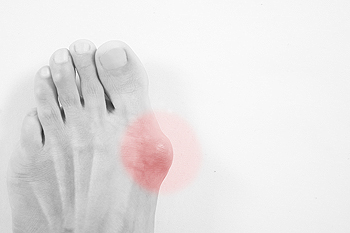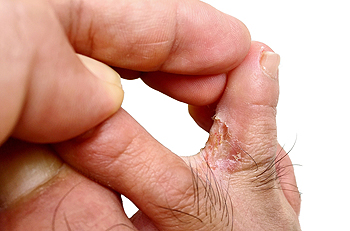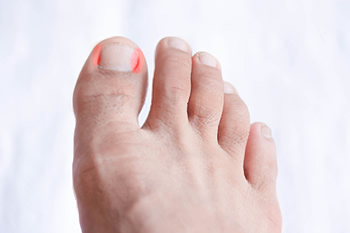Items filtered by date: February 2020
Different Reasons a Bunion May Develop
 Bunions, otherwise recognized as a deformity of the big toe, can be incredibly painful when left untreated. They may easily be diagnosed by looking for a bony protrusion on the side of the big toe, and are typically more common among women and elderly patients. However, there are many reasons why someone may develop a bunion, one of those reasons being genetics. Another contributing factor may have to do with your shoes. Those who commonly wear constraining footwear, such as high heels, or cowboy boots, for extended periods of time may be more likely to develop a bunion. Injuries to the foot, as well as arthritis, can both increase your risk of developing a bunion. To help find relief from the pain bunions typically cause, it is suggested that you wear custom orthotics. For more information on treating bunions and how orthotics may help, please consult with a podiatrist for professional care.
Bunions, otherwise recognized as a deformity of the big toe, can be incredibly painful when left untreated. They may easily be diagnosed by looking for a bony protrusion on the side of the big toe, and are typically more common among women and elderly patients. However, there are many reasons why someone may develop a bunion, one of those reasons being genetics. Another contributing factor may have to do with your shoes. Those who commonly wear constraining footwear, such as high heels, or cowboy boots, for extended periods of time may be more likely to develop a bunion. Injuries to the foot, as well as arthritis, can both increase your risk of developing a bunion. To help find relief from the pain bunions typically cause, it is suggested that you wear custom orthotics. For more information on treating bunions and how orthotics may help, please consult with a podiatrist for professional care.
If you are suffering from bunion pain, contact Dr. Douglas Mckay of New Jersey . Our doctor can provide the care you need to keep you pain-free and on your feet.
What Is a Bunion?
Bunions are painful bony bumps that usually develop on the inside of the foot at the joint of the big toe. As the deformity increases over time, it may become painful to walk and wear shoes. Women are more likely to exacerbate existing bunions since they often wear tight, narrow shoes that shift their toes together. Bunion pain can be relieved by wearing wider shoes with enough room for the toes.
Causes
- Genetics – some people inherit feet that are more prone to bunion development
- Inflammatory Conditions - rheumatoid arthritis and polio may cause bunion development
Symptoms
- Redness and inflammation
- Pain and tenderness
- Callus or corns on the bump
- Restricted motion in the big toe
In order to diagnose your bunion, your podiatrist may ask about your medical history, symptoms, and general health. Your doctor might also order an x-ray to take a closer look at your feet. Nonsurgical treatment options include orthotics, padding, icing, changes in footwear, and medication. If nonsurgical treatments don’t alleviate your bunion pain, surgery may be necessary.
If you have any questions, please feel free to contact one of our offices located in Caldwell, and Galloway, NJ . We offer the newest diagnostic and treatment technologies for all your foot care needs.
Common Symptoms of Athlete’s Foot
 A common fungal infection of the feet is known as athlete’s foot. It is caused by a fungus that thrives in warm and moist environments. These can consist of public swimming pools, locker rooms, and shower room floors. If you are to visit these types of places, it is suggested that appropriate shoes are worn, as this may help to prevent the fungus from entering your skin. There are also other factors that may make it easier for this condition to develop. These may include wearing socks that are wet for the majority of the day, or having a bandage on the skin for an extended period of time which may soften the skin. Common symptoms that are associated with athlete’s foot can include intense itchiness between the toes and on the bottom of the feet, and in more severe cases, blisters may develop. If you feel you have athlete’s foot, it is strongly suggested that you consult with a podiatrist who can guide you toward the proper treatment.
A common fungal infection of the feet is known as athlete’s foot. It is caused by a fungus that thrives in warm and moist environments. These can consist of public swimming pools, locker rooms, and shower room floors. If you are to visit these types of places, it is suggested that appropriate shoes are worn, as this may help to prevent the fungus from entering your skin. There are also other factors that may make it easier for this condition to develop. These may include wearing socks that are wet for the majority of the day, or having a bandage on the skin for an extended period of time which may soften the skin. Common symptoms that are associated with athlete’s foot can include intense itchiness between the toes and on the bottom of the feet, and in more severe cases, blisters may develop. If you feel you have athlete’s foot, it is strongly suggested that you consult with a podiatrist who can guide you toward the proper treatment.
Athlete’s Foot
Athlete’s foot is often an uncomfortable condition to experience. Thankfully, podiatrists specialize in treating athlete’s foot and offer the best treatment options. If you have any questions about athlete’s foot, consult with Dr. Douglas Mckay from New Jersey . Our doctor will assess your condition and provide you with quality treatment.
What Is Athlete’s Foot?
Tinea pedis, more commonly known as athlete’s foot, is a non-serious and common fungal infection of the foot. Athlete’s foot is contagious and can be contracted by touching someone who has it or infected surfaces. The most common places contaminated by it are public showers, locker rooms, and swimming pools. Once contracted, it grows on feet that are left inside moist, dark, and warm shoes and socks.
Prevention
The most effective ways to prevent athlete’s foot include:
- Thoroughly washing and drying feet
- Avoid going barefoot in locker rooms and public showers
- Using shower shoes in public showers
- Wearing socks that allow the feet to breathe
- Changing socks and shoes frequently if you sweat a lot
Symptoms
Athlete’s foot initially occurs as a rash between the toes. However, if left undiagnosed, it can spread to the sides and bottom of the feet, toenails, and if touched by hand, the hands themselves. Symptoms include:
- Redness
- Burning
- Itching
- Scaly and peeling skin
Diagnosis and Treatment
Diagnosis is quick and easy. Skin samples will be taken and either viewed under a microscope or sent to a lab for testing. Sometimes, a podiatrist can diagnose it based on simply looking at it. Once confirmed, treatment options include oral and topical antifungal medications.
If you have any questions, please feel free to contact one of our offices located in Caldwell, and Galloway, NJ . We offer the newest diagnostic and treatment technologies for all your foot care needs.
Pain and Ingrown Toenails
 The medical name for an ingrown toenail is known as onychocryptosis. This can happen as a result of the side of the toenail growing into the skin, and can cause severe pain and discomfort. Additional symptoms may include discharge draining from the affected area, and the side of the toe may appear swollen. A common reason an ingrown toenail may develop can be from shoes worn that do not have adequate room for the toes to move freely in. Trimming your toenails incorrectly may also cause an ingrown toenail. It is beneficial for the nails be trimmed straight across, and not too short. If you notice you have an ingrown toenail, it is advised that you are treated by a podiatrist who can help you to prevent an infection from occurring.
The medical name for an ingrown toenail is known as onychocryptosis. This can happen as a result of the side of the toenail growing into the skin, and can cause severe pain and discomfort. Additional symptoms may include discharge draining from the affected area, and the side of the toe may appear swollen. A common reason an ingrown toenail may develop can be from shoes worn that do not have adequate room for the toes to move freely in. Trimming your toenails incorrectly may also cause an ingrown toenail. It is beneficial for the nails be trimmed straight across, and not too short. If you notice you have an ingrown toenail, it is advised that you are treated by a podiatrist who can help you to prevent an infection from occurring.
Ingrown toenails may initially present themselves as a minor discomfort, but they may progress into an infection in the skin without proper treatment. For more information about ingrown toenails, contact Dr. Douglas Mckay of New Jersey . Our doctor can provide the care you need to keep you pain-free and on your feet.
Ingrown Toenails
Ingrown toenails are caused when the corner or side of a toenail grows into the soft flesh surrounding it. They often result in redness, swelling, pain, and in some cases, infection. This condition typically affects the big toe and may recur if it is not treated properly.
Causes
- Improper toenail trimming
- Genetics
- Improper shoe fitting
- Injury from pedicures or nail picking
- Abnormal gait
- Poor hygiene
You are more likely to develop an ingrown toenail if you are obese, have diabetes, arthritis, or have any fungal infection in your nails. Additionally, people who have foot or toe deformities are at a higher risk of developing an ingrown toenail.
Symptoms
Some symptoms of ingrown toenails are redness, swelling, and pain. In rare cases, there may be a yellowish drainage coming from the nail.
Treatment
Ignoring an ingrown toenail can have serious complications. Infections of the nail border can progress to a deeper soft-tissue infection, which can then turn into a bone infection. You should always speak with your podiatrist if you suspect you have an ingrown toenail, especially if you have diabetes or poor circulation.
If you have any questions, please feel free to contact one of our offices located in Caldwell, and Galloway, NJ . We offer the newest diagnostic and treatment technologies for all your foot care needs.
Common Factors That Influence Developing Toenail Fungus
When fungi gets underneath the toenail, it’s very likely for toenail fungus to form. In order to tell if you have toenail fungus, it’s important you look out for certain signs. Common symptoms of this condition may include discoloration, thickening, or lifting of the nail. In some cases, it’s also been known for fungus to cause the affected toenail to crumble or split. As far as developing toenail fungus, certain factors may increase your likelihood. These factors may include living in a hot or humid climate, having athlete’s foot, being diabetic, spending a lot of time in the water, wearing tightly fitted shoes that cause the feet to sweat excessively, and having a weak immune system. If you feel you might have developed toenail fungus, it’s important you seek help as soon as possible. We recommend you consult with a podiatrist for a proper diagnosis and advised treatment plan.
If left untreated, toenail fungus may spread to other toenails, skin, or even fingernails. If you suspect you have toenail fungus it is important to seek treatment right away. For more information about treatment, contact Dr. Douglas Mckay of New Jersey . Our doctor can provide the care you need to keep you pain-free and on your feet.
Symptoms
- Warped or oddly shaped nails
- Yellowish nails
- Loose/separated nail
- Buildup of bits and pieces of nail fragments under the nail
- Brittle, broken, thickened nail
Treatment
If self-care strategies and over-the-counter medications does not help your fungus, your podiatrist may give you a prescription drug instead. Even if you find relief from your toenail fungus symptoms, you may experience a repeat infection in the future.
Prevention
In order to prevent getting toenail fungus in the future, you should always make sure to wash your feet with soap and water. After washing, it is important to dry your feet thoroughly especially in between the toes. When trimming your toenails, be sure to trim straight across instead of in a rounded shape. It is crucial not to cover up discolored nails with nail polish because that will prevent your nail from being able to “breathe”.
In some cases, surgical procedure may be needed to remove the toenail fungus. Consult with your podiatrist about the best treatment options for your case of toenail fungus.
If you have any questions, please feel free to contact one of our offices located in Caldwell, and Galloway, NJ . We offer the newest diagnostic and treatment technologies for all your foot care needs.



